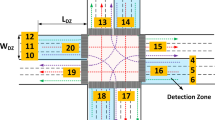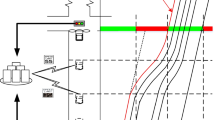Abstract
Traffic signal timing optimization and control are one of the most cost-effective ways of improving urban arterial network congestions. Among various control modes, actuated traffic signal control is designed to provide green times where they are needed and it uses a pre-specified gap-out time to determine early termination of current phase green time. However, the effectiveness of its signal state decisions is limited by its dependence on vehicular information from fixed point sensors. With the emerging wireless communication technology based on cooperative vehicle-infrastructure system known as IntelliDrive, individual vehicular information (e.g., speed, acceleration, and location) is needed to be fully utilized for traffic signal control applications. This paper presents a dynamic gap-out approach that uses individual vehicular information and quantified benefits of the proposed approach via simulation. The timing plans were optimized by the genetic algorithm for both the traditional and the proposed gap-out cases. The results based on a four-leg intersection indicated that the dynamic gap-out reduced vehicular delays by 12.5% over existing regular gap-out.
Similar content being viewed by others
References
Abu-Lebdeh, G. and Benekohal, R. F. (1993). “Genetic algorithms for traffic signal control and queue management of oversaturated twoway arterials.” Transportation Research Record 1727, TRB, National Research Council, Washington, D.C., pp. 61–67.
Akcelik, R. (1997). “Lane-by-lane modeling of unequal lane use and flares`at roundabouts and signalized intersections: The SIDRA solution.” Traffic Engineering + Control, 38(7/8), pp. 388–399.
Bullen, A. G., Hummon, R. N., Bryer, T., and Nekmat R. (1987). “EVIPAS: A computer model for the optimal design of vehicleactuated traffic signal.” Transportation Research Record 1114, Transportation Research Board, National Research Council, Washington, D.C., pp. 103–110.
Chiou, S. (2009). “Simultaneously optimizing link tolls and signal settings in a road network.” Applied Mathematical Modelling, Vol. 33, No. 5, pp. 2311–2323.
Fehon, K. (2004). “Adaptive Traffic Signals are we missing the boat?” DKS Associates, ITE District 6 2004 Annual Meeting.
FHWA (2008). Surrogate safety assessment model, FHWA.
Institute of Transportation Engineers (1999). Traffic engineering handbook, 5th Edition, Prentice-Hall Inc.
Ko, J. (2006). Measurement of freeway traffic flow quality using GPSequipped vehicles, PhD Thesis, the Georgia Institute of Technology, Atlanta, GA.
Mckay, M. D., Beckman, R. J., and Conover, W. J. (1979). “A comparison of three methods for selecting values of input variables in the analysis of output from a computer code.” Technometrics, Vol. 21, No. 2, pp. 239–245.
Messer, C. J., Haenel, H. E., and Koeppe, E. A. (1974). A report on the user’s manual for progression analysis and signal system evaluation routine — PASSER II, TTI Research Report 165-14, College Station, Texas.
Mimbela Y. L. and Klein, L. A. (2000). Summary of vehicle detection and surveillance technologies used in intelligent transportation systems, FHWA ITS Joint Program Office.
Mixon/Hill, Inc. (2009). IntelliDriveSMTechnologies to support HOT lane operations: A white paper, Texas Transportation Institute.
Park, B., Messer, C. J., and Urbanik, T. II. (1999). “Traffic signal optimization program for oversaturated conditions genetic method approach.” Transportation Research Record 1683, TRB, National Research Council, Washington, D.C., pp. 133–142.
Park, B., Mize, C., and Agbolosu-Amison, S. J. (2006). “Improving actuated traffic signal control operations using the concept of DYNAMIC gap-out.” Applications of Advanced Technology in Transportation, Proceedings of the Ninth International Conference, ASCE, Charleston, South Carolina pp. 617–622.
PB Farradyne. (2005). Vehicle Infrastructure Integration (VII). VII Architecture and Functional Requirement Document V 1.1. Prepared for the ITS Joint Program Office. U.S. Department of Transportation.
PTV Planug Transport Verkehr A G. (2006). VISSIM version 4.3 users manual, Innovative Transportation Concepts, Inc.
Robertson, D. (1969). TRANSYT: A traffic network study tool, RRL Report, LR 253, Transport and Road Research Laboratory, Crowthrone.
Salvendy, G. (2001). Handbook of industrial engineering: Technology and operations management, Institute of Industrial Engineers.
Sharma, A., M. Harding, B. Giles, Bullock, D., Sturdevant, J., and Peeta, S. (2008). “Performance requirement and evaluation procedures for advanced wide area detector.” Transportation Research Board Meeting, National Research Council, Washington, D.C., pp. 61–67.
Shelby, S. G. (2001). Design and evaluation of real-time adaptive traffic signal control algorithms, PhD Thesis. University of Arizona, Tucson.
Shladover, S. E. (2005). Preparing the way for vehicle-infrastructure integration, UCB-ITS-PRR-2005-31 California PATH Research Report.
Smith, B. L., Zhang, H., Fontaine, M., and Green, M. (2003). Cell phone probes as an ATMS tool, Research Report No. UVACTS-155-79.
Stevanovic, A., Martin, P. T., and Stevanovic, J. (2007). “VISGAOST: VISSIM-based genetic algorithm optimization of signal timings.” Transportation Research Record 2035, TRB, National Research Council, Washington, D.C., pp. 1–19.
Stevanovic, A., Stevanovic, J., and Martin, P. (2009). “Optimizing signal timings from the field VISGAOST and VISSIM-ASC/3 software-in-the-loop simulation.” Transportation Research Record: Journal of the Transportation Research Board, No. 2128, Transportation Research Board of the National Academies, Washington, D.C., pp. 114–120.
Trafficware Corporation (2009). SYNCHRO users guide, Albany CA.
Wallace, C. E., Courage, K. G., Hadi, M. A., and Gan, A. C. (1998). TRANSYT-7F users guide, M|O|S|T Volume 4, University of Florida Transportation Research Center, Prepared in cooperation with FHWA, U.S. DOT.
Yun, I. (2006). Stochastic optimization method for coordinated actuated signal systems, PhD Dissertation, University of Virginia.
Author information
Authors and Affiliations
Corresponding author
Rights and permissions
About this article
Cite this article
Agbolosu-Amison, S.J., Yun, I. & Park, B.B. Quantifying benefits of a dynamic gap-out feature at an actuated traffic signalized intersection under cooperative vehicle infrastructure system. KSCE J Civ Eng 16, 433–440 (2012). https://doi.org/10.1007/s12205-012-1495-7
Received:
Revised:
Accepted:
Published:
Issue Date:
DOI: https://doi.org/10.1007/s12205-012-1495-7




